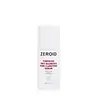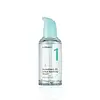What's inside
What's inside
 Key Ingredients
Key Ingredients

 Benefits
Benefits

 Concerns
Concerns

No concerns
 Ingredients Side-by-side
Ingredients Side-by-side

Centella Asiatica Extract
CleansingWater
Skin ConditioningPropanediol
SolventNiacinamide
SmoothingButylene Glycol
HumectantGlycerin
HumectantDimethyl Isosorbide
SolventCaprylic/Capric Triglyceride
MaskingTranexamic Acid
Astringent1,2-Hexanediol
Skin ConditioningPolyglyceryl-10 Stearate
Skin ConditioningSorbitan Sesquioleate
EmulsifyingArginine
MaskingCapryloyl Salicylic Acid
ExfoliatingBetaine
HumectantAcrylates/C10-30 Alkyl Acrylate Crosspolymer
Emulsion StabilisingPentylene Glycol
Skin ConditioningHydrolyzed Hyaluronic Acid
HumectantAllantoin
Skin ConditioningCaprylyl Glycol
EmollientCarbomer
Emulsion StabilisingSorbitan Trioleate
EmulsifyingSodium Hyaluronate
HumectantDisodium EDTA
Anthemis Nobilis Flower Extract
MaskingSorbitan Laurate
EmulsifyingApium Graveolens Seed Extract
AntioxidantLinum Usitatissimum Seed Extract
PerfumingHydroxyethylcellulose
Emulsion StabilisingAcetyl Dipeptide-3 Aminohexanoate
Skin ConditioningAcetyl Dipeptide-1 Cetyl Ester
Skin ConditioningAzulene
Skin ConditioningCentella Asiatica Extract, Water, Propanediol, Niacinamide, Butylene Glycol, Glycerin, Dimethyl Isosorbide, Caprylic/Capric Triglyceride, Tranexamic Acid, 1,2-Hexanediol, Polyglyceryl-10 Stearate, Sorbitan Sesquioleate, Arginine, Capryloyl Salicylic Acid, Betaine, Acrylates/C10-30 Alkyl Acrylate Crosspolymer, Pentylene Glycol, Hydrolyzed Hyaluronic Acid, Allantoin, Caprylyl Glycol, Carbomer, Sorbitan Trioleate, Sodium Hyaluronate, Disodium EDTA, Anthemis Nobilis Flower Extract, Sorbitan Laurate, Apium Graveolens Seed Extract, Linum Usitatissimum Seed Extract, Hydroxyethylcellulose, Acetyl Dipeptide-3 Aminohexanoate, Acetyl Dipeptide-1 Cetyl Ester, Azulene
Water
Skin ConditioningButylene Glycol
HumectantNiacinamide
SmoothingGlycerin
HumectantDipropylene Glycol
Humectant1,2-Hexanediol
Skin ConditioningPanthenol
Skin ConditioningSophora Angustifolia Root Extract
Skin ConditioningAcrylates/C10-30 Alkyl Acrylate Crosspolymer
Emulsion StabilisingPropanediol
SolventDiethoxyethyl Succinate
SolventTromethamine
BufferingHydrogenated Lecithin
EmulsifyingAmmonium Acryloyldimethyltaurate/Vp Copolymer
Betaine
HumectantPantothenic Acid
Skin ConditioningTrehalose
HumectantEthylhexylglycerin
Skin ConditioningGlyceryl Oleate
EmollientSodium Phytate
Allantoin
Skin ConditioningAlpha-Arbutin
AntioxidantHouttuynia Cordata Extract
Skin ConditioningLauryl Glucoside
CleansingMyristyl Glucoside
CleansingPolyglyceryl-6 Laurate
EmulsifyingZinc PCA
HumectantMelia Azadirachta Leaf Extract
Skin ConditioningTocopherol
AntioxidantGlycyrrhiza Uralensis Root Extract
Skin ConditioningMelia Azadirachta Flower Extract
Skin ConditioningCoccinia Indica Fruit Extract
Skin ConditioningCentella Asiatica Extract
CleansingSodium Hyaluronate
HumectantCitric Acid
BufferingSolanum Melongena Fruit Extract
Skin ConditioningBeta-Glucan
Skin ConditioningOcimum Sanctum Leaf Extract
Skin ConditioningHyaluronic Acid
HumectantDecyl Glucoside
CleansingCurcuma Longa Root Extract
MaskingCorallina Officinalis Extract
Skin ConditioningDipotassium Glycyrrhizate
HumectantHydrolyzed Hyaluronic Acid
HumectantSimmondsia Chinensis Seed Oil
EmollientCamellia Sinensis Leaf Extract
AntimicrobialCentella Asiatica Leaf Extract
Skin ConditioningCladosiphon Okamuranus Extract
Skin ConditioningSalix Alba Bark Extract
AstringentSodium Acetylated Hyaluronate
HumectantCoffea Arabica Seed Extract
MaskingBeta-Sitosterol
Emulsion StabilisingPolyglyceryl-10 Stearate
Skin ConditioningCitrus Aurantium Bergamia Leaf Extract
AstringentPinus Densiflora Leaf Extract
AntimicrobialWater, Butylene Glycol, Niacinamide, Glycerin, Dipropylene Glycol, 1,2-Hexanediol, Panthenol, Sophora Angustifolia Root Extract, Acrylates/C10-30 Alkyl Acrylate Crosspolymer, Propanediol, Diethoxyethyl Succinate, Tromethamine, Hydrogenated Lecithin, Ammonium Acryloyldimethyltaurate/Vp Copolymer, Betaine, Pantothenic Acid, Trehalose, Ethylhexylglycerin, Glyceryl Oleate, Sodium Phytate, Allantoin, Alpha-Arbutin, Houttuynia Cordata Extract, Lauryl Glucoside, Myristyl Glucoside, Polyglyceryl-6 Laurate, Zinc PCA, Melia Azadirachta Leaf Extract, Tocopherol, Glycyrrhiza Uralensis Root Extract, Melia Azadirachta Flower Extract, Coccinia Indica Fruit Extract, Centella Asiatica Extract, Sodium Hyaluronate, Citric Acid, Solanum Melongena Fruit Extract, Beta-Glucan, Ocimum Sanctum Leaf Extract, Hyaluronic Acid, Decyl Glucoside, Curcuma Longa Root Extract, Corallina Officinalis Extract, Dipotassium Glycyrrhizate, Hydrolyzed Hyaluronic Acid, Simmondsia Chinensis Seed Oil, Camellia Sinensis Leaf Extract, Centella Asiatica Leaf Extract, Cladosiphon Okamuranus Extract, Salix Alba Bark Extract, Sodium Acetylated Hyaluronate, Coffea Arabica Seed Extract, Beta-Sitosterol, Polyglyceryl-10 Stearate, Citrus Aurantium Bergamia Leaf Extract, Pinus Densiflora Leaf Extract
 Reviews
Reviews

Ingredients Explained
These ingredients are found in both products.
Ingredients higher up in an ingredient list are typically present in a larger amount.
1,2-Hexanediol is a synthetic liquid and another multi-functional powerhouse.
It is a:
- Humectant, drawing moisture into the skin
- Emollient, helping to soften skin
- Solvent, dispersing and stabilizing formulas
- Preservative booster, enhancing the antimicrobial activity of other preservatives
Acrylates/C10-30 Alkyl Acrylate Crosspolymer is a synthetic polymer. It is used to thicken and improve the texture of products. Due to its properties, it can prevent water and oil ingredients from separating.
Allantoin is a soothing ingredient known for its protective and moisturizingg properties. Because of this, it is often added to products with strong active ingredients.
Studies show higher concentrations of this ingredient can promote wound healing.
Though it can be derived from the comfrey plant, allantoin is produced synthetically for cosmetic products to ensure purity.
Learn more about AllantoinBetaine is a common humectant (a substance that promotes retention of moisture). It's known to be gentle on the skin and can help balance hydration.
This ingredient is best for improving hydration and soothing irritated skin. Studies also show it helps even out skin tone.
Fun fact: Betaine is naturally created in the skin and body. The kind found within cosmetic products can be either plant-derived or synthetic.
Another name for betaine is trimethylglycine.
Learn more about BetaineButylene Glycol (or BG) is used within cosmetic products for a few different reasons:
Overall, Butylene Glycol is a safe and well-rounded ingredient that works well with other ingredients.
Though this ingredient works well with most skin types, some people with sensitive skin may experience a reaction such as allergic rashes, closed comedones, or itchiness.
Learn more about Butylene GlycolCentella Asiatica Extract (Centella) is derived from an herb native to Southeast Asia. It is famous for its anti-inflammatory and soothing properties.
Centella is rich in antioxidants and amino acids, such as Madecassic Acid and Asiaticoside.
Studies show the compounds in centella help with:
The combination of all these properties makes centella effective at soothing, hydrating, and protecting the skin.
Other great components of centella include Vitamin A, vitamin C, several B vitamins, and Asiatic Acid.
Fun fact: Centella has been used as a medicine and in food for many centuries. As a medicine, it is used to treat burns, scratches, and wounds.
Learn more about Centella Asiatica ExtractGlycerin is already naturally found in your skin. It helps moisturize and protect your skin.
A study from 2016 found glycerin to be more effective as a humectant than AHAs and hyaluronic acid.
As a humectant, it helps the skin stay hydrated by pulling moisture to your skin. The low molecular weight of glycerin allows it to pull moisture into the deeper layers of your skin.
Hydrated skin improves your skin barrier; Your skin barrier helps protect against irritants and bacteria.
Glycerin has also been found to have antimicrobial and antiviral properties. Due to these properties, glycerin is often used in wound and burn treatments.
In cosmetics, glycerin is usually derived from plants such as soybean or palm. However, it can also be sourced from animals, such as tallow or animal fat.
This ingredient is organic, colorless, odorless, and non-toxic.
Glycerin is the name for this ingredient in American English. British English uses Glycerol/Glycerine.
Learn more about GlycerinHydrolyzed Hyaluronic Acid is a form of hyaluronic acid. It is created by the hydrolysis of hyaluronic acid with a high molecular weight. Once created, Hydrolyzed Hyaluronic Acid has a low molecular weight.
Low molecular weight HA has been shown to hydrate and increase elasticity of the skin. Increasing elasticity is also associated with reduction of wrinkle depth.
One study found topical low molecular weight hyaluronic acid may be considered for the treatment of rosacea in the adult population. However, we always recommend speaking with a professional about your skin concerns.
Hyaluronic acids are a humectant. This means they draw moisture from the air. Hyaluronic acids help moisturize, soothe, and protect the skin.
Read more about other common forms of hyaluronic acid:
Learn more about Hydrolyzed Hyaluronic AcidNiacinamide is a multitasking form of vitamin B3 that strengthens the skin barrier, reduces pores and dark spots, regulates oil, and improves signs of aging.
And the best part? It's gentle and well-tolerated by most skin types, including sensitive and reactive skin.
You might have heard of "niacin flush", or the reddening of skin that causes itchiness. Niacinamide has not been found to cause this.
In very rare cases, some individuals may not be able to tolerate niacinamide at all or experience an allergic reaction to it.
If you are experiencing flaking, irritation, and dryness with this ingredient, be sure to double check all your products as this ingredient can be found in all categories of skincare.
When incorporating niacinamide into your routine, look out for concentration amounts. Typically, 5% niacinamide provides benefits such as fading dark spots. However, if you have sensitive skin, it is better to begin with a smaller concentration.
When you apply niacinamide to your skin, your body converts it into nicotinamide adenine dinucleotide (NAD). NAD is an essential coenzyme that is already found in your cells as "fuel" and powers countless biological processes.
In your skin, NAD helps repair cell damage, produce new healthy cells, support collagen production, strengthen the skin barrier, and fight environmental stressors (like UV and pollution).
Our natural NAD levels start to decline with age, leading to slower skin repair, visible aging, and a weaker skin barrier. By providing your skin niacinamide, you're recharging your skin's NAD levels. This leads to stronger, healthier, and younger looking skin.
Another name for vitamin B3 is nicotinamide. This vitamin is water-soluble and our bodies don't store it. We obtain Vitamin B3 from either food or skincare. Meat, fish, wheat, yeast, and leafy greens contain vitamin B3.
The type of niacinamide used in skincare is synthetically created.
Learn more about NiacinamidePolyglyceryl-10 Stearate is a skin conditioner with emollient and emulsifier properties.
It is an esther of stearic acid and Polyglycerin-10.
This ingredient may not be Malassezia folliculitis, or fungal-acne safe.
Learn more about Polyglyceryl-10 StearatePropanediol is an all-star ingredient. It softens, hydrates, and smooths the skin.
It’s often used to:
Propanediol is not likely to cause sensitivity and considered safe to use. It is derived from corn or petroleum with a clear color and no scent.
Learn more about PropanediolSodium Hyaluronate is hyaluronic acid's salt form. It is commonly derived from the sodium salt of hyaluronic acid.
Like hyaluronic acid, it is great at holding water and acts as a humectant. This makes it a great skin hydrating ingredient.
Sodium Hyaluronate is naturally occurring in our bodies and is mostly found in eye fluid and joints.
These are some other common types of Hyaluronic Acid:
Learn more about Sodium HyaluronateWater. It's the most common cosmetic ingredient of all. You'll usually see it at the top of ingredient lists, meaning that it makes up the largest part of the product.
So why is it so popular? Water most often acts as a solvent - this means that it helps dissolve other ingredients into the formulation.
You'll also recognize water as that liquid we all need to stay alive. If you see this, drink a glass of water. Stay hydrated!
Learn more about Water